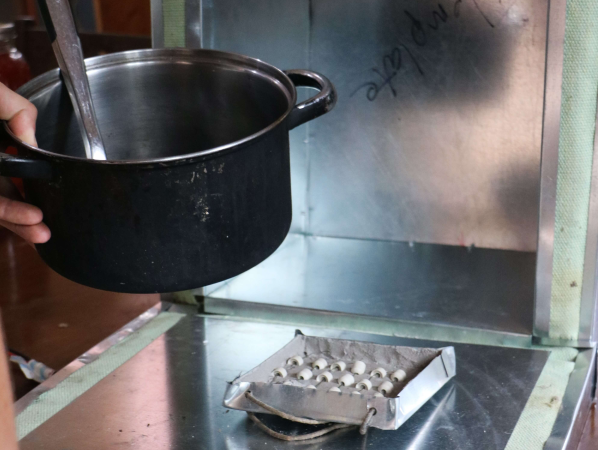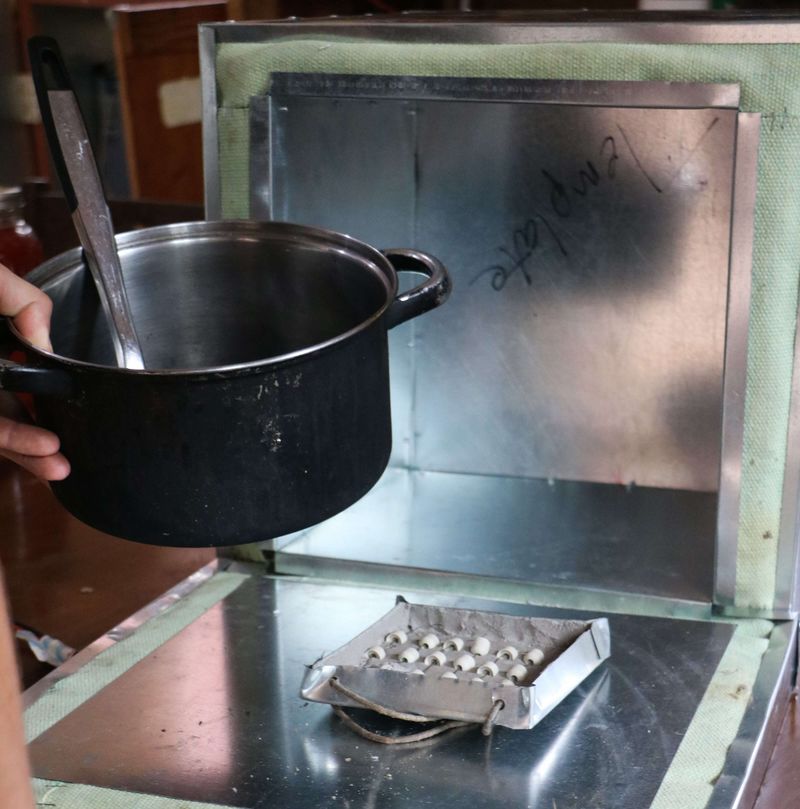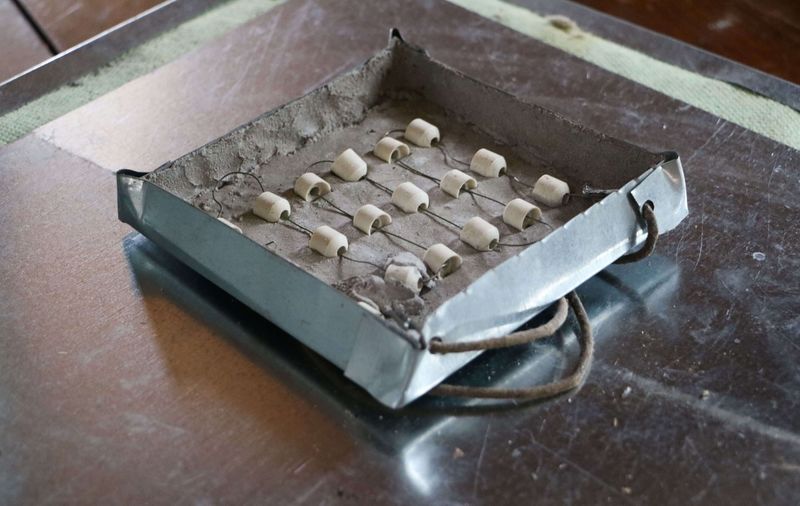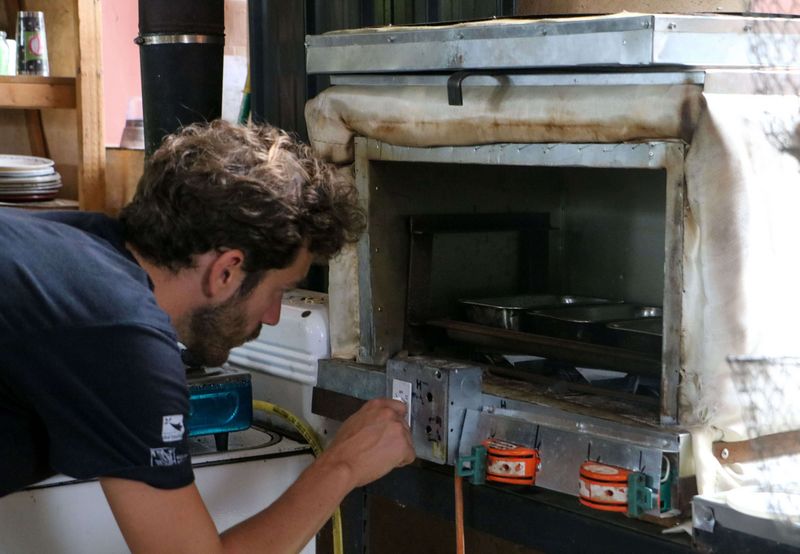(Page créée avec « ====Warum sind diese Solarkocher so vielversprechend? ==== ») |
(Page créée avec « Beim "normalen" Kochen wird sehr viel Energie schnell und sehr ineffizient verbraucht. Beim Kochen auf einem Herd oder in einem Backofen geht die meiste Wärme verloren un... ») |
||
| Ligne 27 : | Ligne 27 : | ||
====Warum sind diese Solarkocher so vielversprechend? ==== | ====Warum sind diese Solarkocher so vielversprechend? ==== | ||
| − | + | Beim "normalen" Kochen wird sehr viel Energie schnell und sehr ineffizient verbraucht. Beim Kochen auf einem Herd oder in einem Backofen geht die meiste Wärme verloren und wird nicht an die Lebensmittel weitergegeben. Die neue Kochtechnologie, mit der wir arbeiten, heißt '''Insulated Solar Electric Cookers''', oder '''ISECs'''. Diese Kocher sind sehr effizient. Auf der Living Energy Farm nutzen wir Solarenergie, und das macht uns zu 100% energieautark auf der Ebene des Haushalts. Aber im Gegensatz zu anderen netzunabhängigen Projekten fließen 90 % unseres Stroms nicht durch eine Batterie. Vielmehr leiten unsere Solarmodule den Strom direkt an seinen Einsatzort. Das Team von Cal Poly hatte die gleiche Idee, und die ISECs nutzen die Energie direkt von den Solarzellen. Das macht diese Art der Nutzung von Solarenergie "radikal kostengünstig", um den von den Cal Poly-Forschern geprägten Begriff zu verwenden. In der Praxis haben wir festgestellt, dass die ISECs effektiver sind als jede andere auf dem Markt erhältliche Solarkochertechnologie". Es gibt viele Solarkocher auf dem Markt, aber die ISECs sind am einfachsten zu gebrauchen und bieten bei weitem das effektivste Mittel zum solaren Kochen bei suboptimalem Wetter. '''Und sie sind billig zu bauen!''' | |
| − | |||
====What to Expect==== | ====What to Expect==== | ||
Version du 22 juillet 2023 à 10:09
Description
Der isolierte elektrische Solarkocher (Insulated Solar Electric Cooker, ISEC) ist eine wärmeisolierte, elektrisch beheizte Kochbox, die es dem Benutzer ermöglicht, über einen langen Zeitraum mit geringer Energie aus einem Solarpanel, aus dem Stromnetz oder aus einer Kombination beliebiger Stromquellen zu kochen. Energie kann thermisch oder in einer Batterie gespeichert werden. Das Kochen mit wenig Energieeinsatz spart Geld, indem es die Stromrechnungen (bei Netzanschluss) oder die Anzahl der gekauften Solarpaneele reduziert. Die Einfachheit der ISECooking-Technologie ermöglicht es, sie dort herzustellen, wo sie gebraucht wird.
Introduction
Das ISEC-Projekt wurde an der CalPoly University in Kalifornien dank Pete Schwartz ins Leben gerufen und wird nun von Mitstreitern in der ganzen Welt weitergeführt.
Diese Tutorial basiert auf dem Handbuch von Alexis Ziegler von der Living Energy Farm, einer Gemeinschaft in Virginia, USA, die ohne fossile Energie auskommen will.
Hintergrund
Nach Angaben der Weltgesundheitsorganisation kochen 3 Milliarden Menschen auf der Welt mit Biomasse und Kohle; infolgedessen sterben 4 Millionen Menschen an den damit verbundenen Emissionen. In vielen Regionen hat das Kochen mit Biomasse zur Abholzung der Wälder geführt und kann eine enorme Umweltverschmutzung verursachen. Frauen werden durch sexuelle Übergriffe bedroht, wenn sie ihre Siedlungen verlassen, um Brennholz zu sammeln oder Kohle zu kaufen. Das Ziel unserer Forschung ist es, die Umweltbelastung und die gesundheitlichen Probleme, die durch das Kochen mit Biomasse entstehen, zu minimieren.
Warum sind diese Solarkocher so vielversprechend?
Beim "normalen" Kochen wird sehr viel Energie schnell und sehr ineffizient verbraucht. Beim Kochen auf einem Herd oder in einem Backofen geht die meiste Wärme verloren und wird nicht an die Lebensmittel weitergegeben. Die neue Kochtechnologie, mit der wir arbeiten, heißt Insulated Solar Electric Cookers, oder ISECs. Diese Kocher sind sehr effizient. Auf der Living Energy Farm nutzen wir Solarenergie, und das macht uns zu 100% energieautark auf der Ebene des Haushalts. Aber im Gegensatz zu anderen netzunabhängigen Projekten fließen 90 % unseres Stroms nicht durch eine Batterie. Vielmehr leiten unsere Solarmodule den Strom direkt an seinen Einsatzort. Das Team von Cal Poly hatte die gleiche Idee, und die ISECs nutzen die Energie direkt von den Solarzellen. Das macht diese Art der Nutzung von Solarenergie "radikal kostengünstig", um den von den Cal Poly-Forschern geprägten Begriff zu verwenden. In der Praxis haben wir festgestellt, dass die ISECs effektiver sind als jede andere auf dem Markt erhältliche Solarkochertechnologie". Es gibt viele Solarkocher auf dem Markt, aber die ISECs sind am einfachsten zu gebrauchen und bieten bei weitem das effektivste Mittel zum solaren Kochen bei suboptimalem Wetter. Und sie sind billig zu bauen!
What to Expect
This technology is new and changing quickly. This document will tell you how to build ISECs. A materials source list is at the end of this document. The smaller ISECs function like a crock pot. All ISECs cook slowly, though the larger ones can cook somewhat more quickly. A 100 watt ISEC will cook 2 - 3 kg of food in winter or in partly cloudy weather, and more in sunnier weather. Larger ISECs will cook greater quantities of food. Slow cooking means less burned food, less carcinogenic substances in the food (which are created by very high temperatures), and more flavorful food. Slow cooking does involve changing the rhythm of cooking. Preparation is done ahead of time. ISECs could never replace all other cooking fuels in every climate, but they could do most of the cooking we need.
Community Scale Cooking
At LEF, we have built several biogas digesters, numerous solar cooking devices, as well as rocket stoves that use wood. Overall, a combination of biogas and ISECs seem to be the best approach to a cost effective, year-round, fully renewable approach to community scale cooking.The mix of biogas and ISECs is optimal because it allows cooking in any weather, is scalable to most any size, and can be adapted to most any climate. Biogas in a temperate climate is challenging because a biogas digester needs to stay very warm and cannot be indoors. And tending a biogas digester is like taking care of an animal -- you need to feed it every day, and pay some attention to it. That is easiest to do on a community scale.
The Value of Integrating Energy Systems
The original ISEC project developed at Cal Poly uses a 100 watt, 12 volt, well insulated cooker. The fact that they have proven that you can cook with only 100 watts is great! But such small power sources do not work in cloudy weather. We have found at LEF that our cooks always favor more powerful cookers. Our largest ISEC at LEF runs at 180 volts. It will cook quite well in cloudy weather. The ISEC project aims to provide inexpensive cookers for low income families all over the world. If 10 or 20 people can share a cooking facility, then it is possible to make much more effective cookers at higher voltages that work in cloudier weather, as well as providing other services, at a similar per-capita cost. The problem is, of course, that many low income communities do not have the up-front capital to build larger energy systems regardless of improved overall efficacy. The right balance of cost, efficiency, and scale is and will remain on ongoing question. Our hope here is to provide options.
ISECs Designs -- Your Options
The two types of cookers we have developed at LEF are bucket cookers and box cookers. The bucket cooker we call Perl is made with a 5 gallon bucket and perlite. The Cal Poly crew has expanded on this idea by using larger buckets with more insulation. For a small cooker, Perl works well. It is cheap and easy to build. It uses a stainless pot that can be removed from the cooker and can be any size up to about 6 quarts. The heat source is a homemade burner. It is also possible to build a bucket cooker can be built with wood ashes, though that’s not a great approach. Instructions follow. Our favorite cookers are Roxes -- box cookers made with rockwool sheet and sheet metal. Roxies can be built in many different sizes and insulation levels using rockwool and/ or fiberglass. Naturally, larger ISECs or ISECs with thicker insulation levels cost more. Roxies can use pots that you already have in your kitchen.Youtube
Matériaux
- High Temperature Wire: If you have heavy gauge wire around you can use it, but for short runs in the amperage needed for most ISECS, 14 - 16 gauge is fine.
- Metal Shears -- Brand name “aviation shears” are the best. Ideally, you want one straight cut
- Nichrome Wire
- Aramid or other non-flammable fabric
- High Temperature RTV Silicon
- Thermal Switches
- Heavier Aluminum Foil
- High Temperature Ceramic Beads
- Silicon Tubing, High Temperature (for steam venting)
- Inexpensive Wire Stripper/ Crimper/ Cutter
- Duct Metal
- Refractory Cement
- Rockwool Batts
- Aluminum Tape
Outils
Étape 1 - Construction Manual of Alexis Ziegler
Here is the link of the step-by-step construction manual to built the PEARL et the ROXIES cookers: https://conev.org/ISECmanual14.pdf
Here is the link to a construction video of an ISEC Burner : https://www.youtube.com/watch?v=uzZPstX1CbQ
Notes et références
Interview vidéo réalisé en août 2021 par Sidonie Francès et Guénolé Conrad.
Tutoriel rédigé par Guénolé Conrad.
- Pete Schwartz blog, compiling research advances on ISEC.
- Pete Schwartz Youtube channel reporting his experiments, in particular with thermal storage.
- Living Energy Farm website, gathering their feedbacks and manuals on their energy systems.
Published





 Français
Français English
English Deutsch
Deutsch Español
Español Italiano
Italiano Português
Português